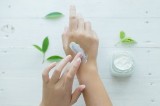How to regenerate the skin of your hands after using antibacterial agents?
2020-04-28

Covid awareness caused on us frantic hand washing and using aggressive alcohol sanitizers.
Yet, abusing cleansers like that dry out and damage the skin, that now required intense care
and moisturizing. So, let’s get to it.
Hand creams are meant to maintain proper moisturizing, regeneration, support the acid mantle
and keep the sking from liquid loss. Key ingredients in charge of moisturization and nourishment
are known as emollients – mostly based on shea or cocoa butter, sweet almond, jojoba, avocado,
raspberry seed and other oils. These components, to play their role, require humectants, special
water-binding elements, most often found in aloe, glycerin or hyaluronic acid. Urea, vitamins A and E
would amplify the formula even further. Creams with such a makeup will work not only for hand skin
care, bot for other body parts, too – like, for example, Hagi’s Hand&Body Multicream does.
Masks can also be an option for ultimate palm nourishing. These ones mostly appear in the
form of gloves to put on and keep for around 20 -30 minutes. The action is similar to those
meant for face care, delivering deep treatment and restoring dried hand skin.
As all-in-one solutions are always on high demand, formulas that combine sanitizing properties with
simultaneous skin nourishing. We could already see such brands like Bandi going this way making
antibacterial hand creams.
A combination of moisturizing and antibacterial (like Tea tree) oils helps to achieve a sort of
two-phase action. Other sanitizing options for this kind of formulas can be delivered by almond
acid, silver, iodine, zinc or chlorine compounds, garlic, lavender, thyme essences or mentioned
Tea tree oil. Aloe works for it as well for its naturally combined nurturing and antibacterial
properties, too. In front of the isolation and excessive „germ war”, such products will really help
save the natural body skin barriers in the long term, won’t they?